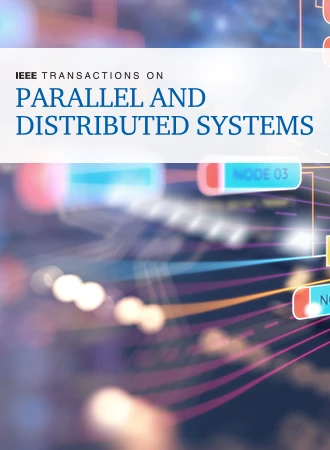Integrated and Fungible Scheduling of Deep Learning Workloads Using Multi-Agent Reinforcement Learning
IF 5.6
2区 计算机科学
Q1 COMPUTER SCIENCE, THEORY & METHODS
IEEE Transactions on Parallel and Distributed Systems
Pub Date : 2024-12-25
DOI:10.1109/TPDS.2024.3522333
引用次数: 0
Abstract
GPU clusters have been widely used to co-locate various deep learning (DL) workloads in a multi-tenant way. Although such resource sharing can significantly reduce training cost, resource contention and interference among co-located workloads make task scheduling very complex and challenging. To simplify the scheduling problem, existing algorithms usually divide the procedure of scheduling into two sub-tasks, i.e., task placement and resource allocation, and allocate resources according to pre-defined and fixed resource demands. However, such a paradigm significantly constrains the selection of potential scheduling solutions. In this article, we present MAIFS, a novel multi-agent reinforcement learning based scheduling algorithm that handles task placement and resource allocation integratedly, and allows fungible resource allocation based on resource sensitivity of DL workloads. The core of MAIFS lies in two mechanisms. The multi-agent attention mechanism is designed to learn and share inter-related resource state features observed from different agents, which enables agents to explore fungible resource allocation solutions. The dynamic coordination graph mechanism is designed for coordinating interactive task placement decisions of agents during integrated scheduling, so as to mitigate potential task conflicts. Simulated experiments using two large scale production DL workload traces and physical deployment experiments based on a Kubernetes based GPU cluster show that MAIFS can outperform state-of-the-art scheduling algorithms by up to 44% in terms of makespan and 46% in terms of job completion time (JCT).基于多智能体强化学习的深度学习工作负载集成可替换调度
GPU集群已被广泛用于以多租户方式共同定位各种深度学习(DL)工作负载。虽然这种资源共享可以显著降低培训成本,但资源争用和协同工作负载之间的干扰使得任务调度非常复杂和具有挑战性。为了简化调度问题,现有算法通常将调度过程分为任务布置和资源分配两个子任务,并根据预定义的固定资源需求分配资源。然而,这种范式极大地限制了潜在调度解决方案的选择。在本文中,我们提出了一种新的基于多智能体强化学习的调度算法MAIFS,该算法集成处理任务放置和资源分配,并允许基于深度学习工作负载的资源敏感性进行可替代的资源分配。MAIFS的核心在于两种机制。多智能体关注机制旨在学习和共享从不同智能体观察到的相互关联的资源状态特征,使智能体能够探索可替代的资源分配方案。设计了动态协调图机制,在集成调度过程中协调agent的交互任务布局决策,以缓解潜在的任务冲突。使用两个大规模生产DL工作负载跟踪和基于Kubernetes的GPU集群的物理部署实验的模拟实验表明,MAIFS在makespan方面可以比最先进的调度算法高出44%,在作业完成时间(JCT)方面高出46%。
本文章由计算机程序翻译,如有差异,请以英文原文为准。
求助全文
约1分钟内获得全文
求助全文
来源期刊

IEEE Transactions on Parallel and Distributed Systems
工程技术-工程:电子与电气
CiteScore
11.00
自引率
9.40%
发文量
281
审稿时长
5.6 months
期刊介绍:
IEEE Transactions on Parallel and Distributed Systems (TPDS) is published monthly. It publishes a range of papers, comments on previously published papers, and survey articles that deal with the parallel and distributed systems research areas of current importance to our readers. Particular areas of interest include, but are not limited to:
a) Parallel and distributed algorithms, focusing on topics such as: models of computation; numerical, combinatorial, and data-intensive parallel algorithms, scalability of algorithms and data structures for parallel and distributed systems, communication and synchronization protocols, network algorithms, scheduling, and load balancing.
b) Applications of parallel and distributed computing, including computational and data-enabled science and engineering, big data applications, parallel crowd sourcing, large-scale social network analysis, management of big data, cloud and grid computing, scientific and biomedical applications, mobile computing, and cyber-physical systems.
c) Parallel and distributed architectures, including architectures for instruction-level and thread-level parallelism; design, analysis, implementation, fault resilience and performance measurements of multiple-processor systems; multicore processors, heterogeneous many-core systems; petascale and exascale systems designs; novel big data architectures; special purpose architectures, including graphics processors, signal processors, network processors, media accelerators, and other special purpose processors and accelerators; impact of technology on architecture; network and interconnect architectures; parallel I/O and storage systems; architecture of the memory hierarchy; power-efficient and green computing architectures; dependable architectures; and performance modeling and evaluation.
d) Parallel and distributed software, including parallel and multicore programming languages and compilers, runtime systems, operating systems, Internet computing and web services, resource management including green computing, middleware for grids, clouds, and data centers, libraries, performance modeling and evaluation, parallel programming paradigms, and programming environments and tools.
 求助内容:
求助内容: 应助结果提醒方式:
应助结果提醒方式:


